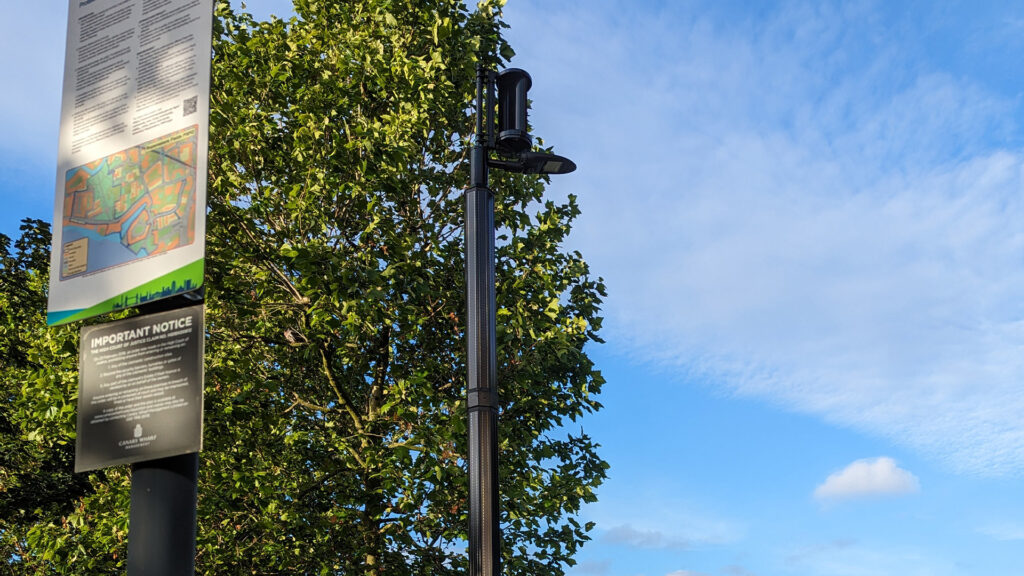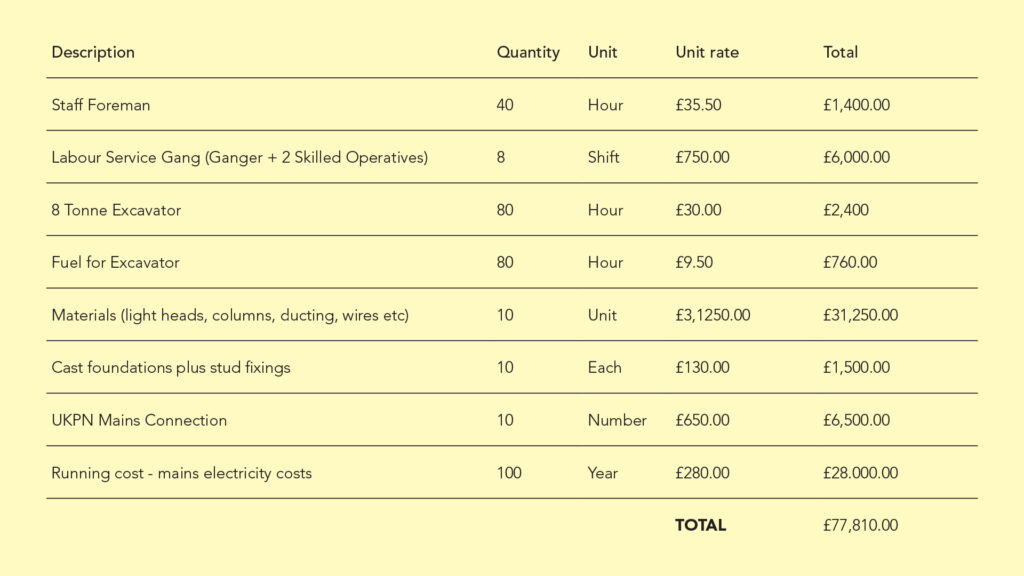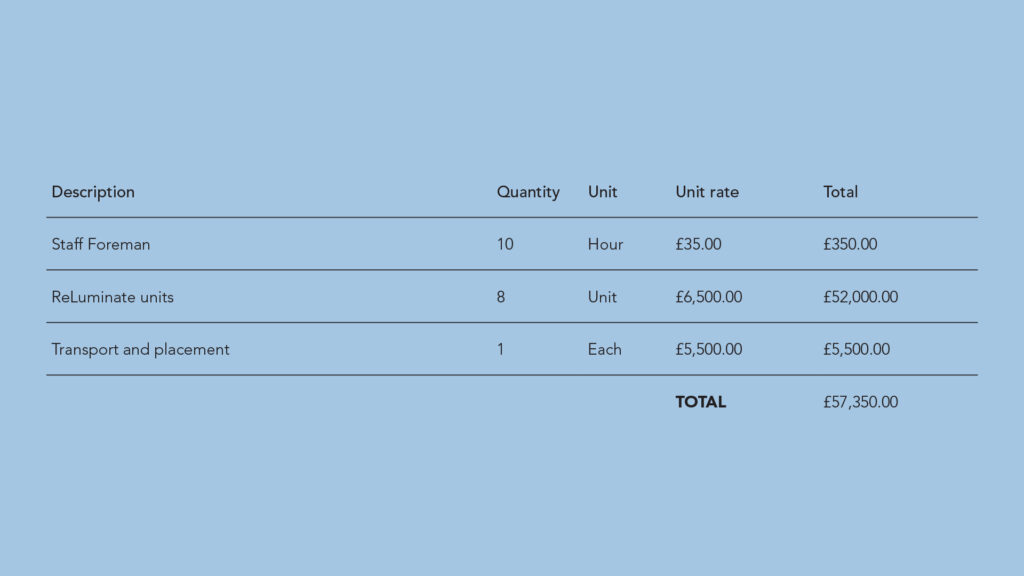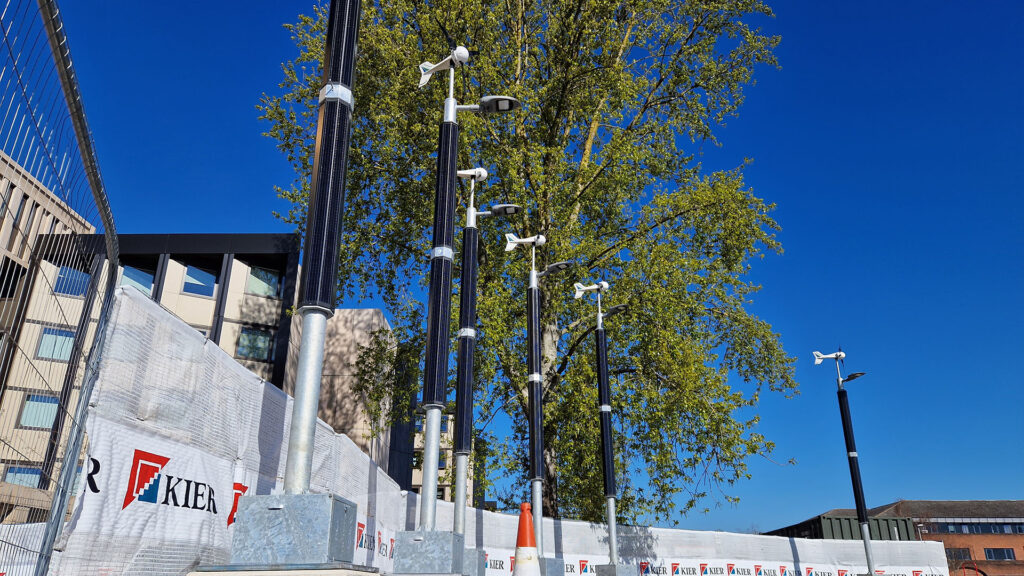A recent study of a sizeable off-grid lighting project using ReLuminate demonstrates cost and carbon emissions benefits on an area of 4000m² of lighting over a period of time as compared to fixed and alternative lighting installations*
Fixed infrastructure for powering this type of project will necessitate the cost and use of ducting, wiring, and labour, as well as ongoing maintenance. Relocation needs will incur additional risk, time and costs associated with planning, labour and safety, especially when breaking ground to relocate columns or mains power supplies.
More flexible solutions with generator power are available, however are even more costly due to management time, fuel and maintenance. Solar only options are available too, however, these have historically proven to be unreliable, particularly in winter months.

| Recommendation | The proposal is that the ReLuminate lights are used in all applications instead of mains, fossil or hydrogen powered alternatives. This would cover all roadways and parking areas whether short-term, temporary / semi-permanent or long-term provision. |
| Financial | Cost Benefit of £20,400* |
| Environmental | Designed in conjunction with the planning commitments to minimise impacts on landscape, ecology and visual amenity Zero carbon solution in use saving 11.4 tonnes of CO2*, helping minimise greenhouse gas (GHG) emissions from fuel use in line with the project’s environmental design principles. |
| Flexibility | Reconfigurable as the project evolves with no cost other than relocating the free-standing columns. |
| Energy | Self-generated power – zero energy costs. |
| Local Resource Depletion | Reducing draw on the local power infrastructure. |
| Legacy | Potential to convert the columns onto to a permanent off grid solution to remain post works. |
The potential of long-term high waste and cost (Capex and Opex) will relate to traditional wired lighting solutions.
Movable solutions come with a high costs due to refuelling needs ( hydrogen or petrol / diesel generator power), relying on constant and regular manual interventions to keep the system running, risking resultant ‘power outages’.
Traditional off-grid solar only solutions are unable to give reliable all year-round performance due to the limits of physics – risking insufficient lighting through long winter nights with unforeseen potentially negative consequences.
The Benefits
A combined solar and wind powered off-grid lighting solution overcomes the challenges of traditional mains powered and solar only alternatives and comes with many benefits.
| Proven | Off grid solution that actually works…. Includes wind and solar power generation for all year round lighting. |
| Minimise risk | The off grid nature also mitigates against power outages to access lighting that may impact on the ability to manage an emergency, contributing to improved site Health & Safety. |
| Mobile | No ground work requirement for fixing the units, reducing labour and cost. A fork lift or similar is required for relocation, enabling speed and agility. |
| Flexible | Design scheme flexibility as there are no barriers to installation from underground services and utilities, reducing time and hassle. |
| Adjustable | Configurable for timing and light outputs to limit the hours of lighting when required – providing sympathy to surrounding neighbours. |
| Low maintenance | No manual ongoing intervention required – no fuss – no hassle – reduced costs, increasing efficiency of works. |
| Zero carbon | Zero negative impact on the environment – Zero carbon solution contributing to your company’s net zero goals. |
| Self-cleaning | Vertical solar for aesthetic benefit; self-cleaning maximising sustainability and durability and reducing the cost of replacement and maintenance. |
| Optical control | High quality luminaire with good optical control giving 500m² lighting spread per column. 8 units therefore covering ~1 acre giving increased light coverage to traditional light solutions. |
| Reduced artificial light | Reduced number of columns required by ~20%, further reducing the perceived amount of artificial light provided by these columns in a compound or along lit routes (saving ~6-7 columns per kilometre for example), thus additionally reducing costs. |
| LED Lights | Low insect attrition rate offered by LED lights contributing to bio diversity goals. |
| Modular | Easy relocation of columns and adaptation of the lighting heads allowing control of light coverage so as not to disturb local habitats, thus contributing to biodiversity goals. |
| Wildlife friendly | Wildlife friendly light colour head option available to further minimise ecological effects on habitat and associated species such as birds and bats, thus contributing to biodiversity goals. |
| Less pollution | Low glare and light spill lessening visual impact of artificial light and pollution contributing to biodiversity goals and reducing potential complaints. |
The Comparison
The below tables compare CAPEX OPEX traditional wired column lights with ReLuminate.


Economic and Environmental Calculations
All the calculations should be considered in scale based on the overall project
And are based on ReLuminate performance values of:
500m² lighting spread per column equivalent to 30lm of coverage.
10 year life of units.
Break even in under 5 years and a cost saving total of ~£20,400 over 10 years.
Based on zero cost in use for powering a ReLuminate solution
NB
The Running cost of generator hire, fuel and labour for daily refill is likely in excess of £30,000 per annum.
No allowance has been factored into the mains electricity costs. This should be compared against the zero running costs of the ReLuminate solution.
8 units over 10 years therefore equals more than 11.5 tonnes of CO2e savings.
The current UK electricity carbon factor as published by the Department for Environment, Food & Rural Affairs (DEFRA) is 0.233 kgCO2e per kWh of electricity consumed.
We have based our calculations on a 150W light head unit at 11.4 hours per night average over 365 days.
So 233g of CO2e at 0.15 kWh = 34.95g / hour.
4161 hours at 34.95g = 145 Kg of CO2e saving per light unit.
8 units over 10 years therefore equals more than 11.5 tonnes of CO2e savings.
